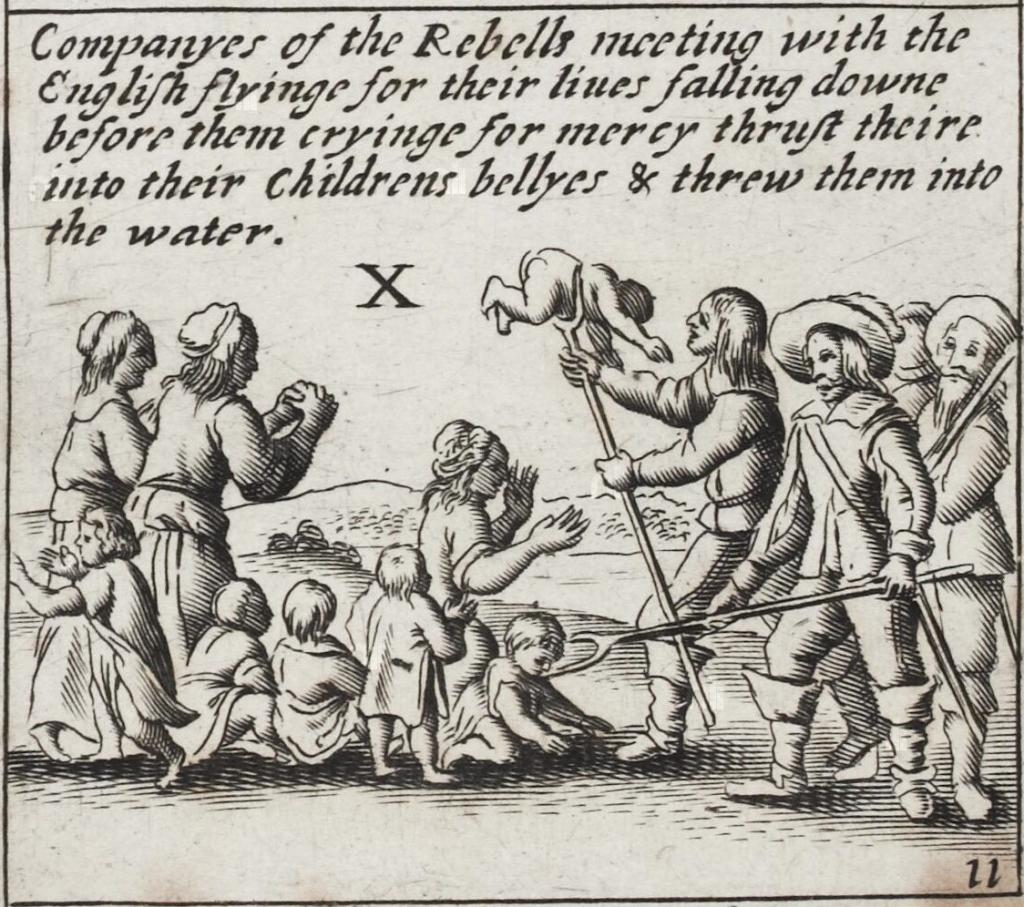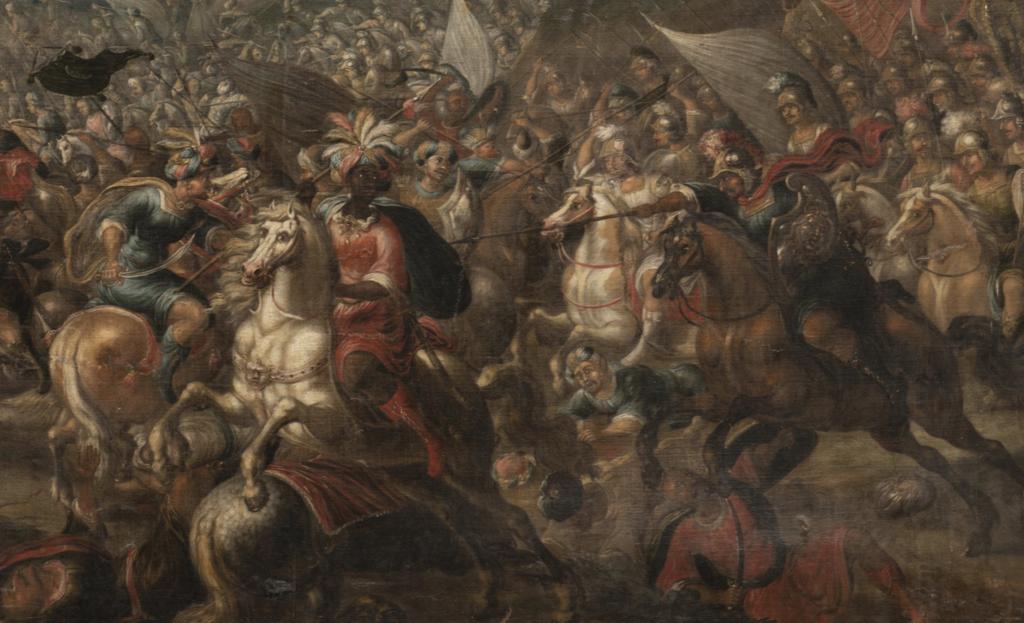We often hear the word “genocide” today, and it unquestionably describes a vital concept. The word is usually dated to 1944, when it was coined by the brilliant Polish-Jewish lawyer Raphael Lemkin, who had been studying related concepts for some decades. Surely, we think, Lemkin’s word was a new invention designed to describe a new phenomenon. But long before that, English-speakers had another word that meant much the same thing, and in many cases – not all – it grew from strictly Christian and Biblical origins, and comments on some key scriptural texts that I have been discussing. Both as language and concept, genocide has a Christian prehistory.
The word in question is “extirpate,” which begins as a biological term for rooting out or pulling up by the roots. Latin stirps means the root or stock of the tree, so utterly removing it is to extirpate. That meaning enters English in the fifteenth century, and “extirpate” is first recorded in the 1530s. To extirpate a people, then, meant not just to cause them terrible damage, but to end their biological existence. (The Latin word radix means root, which gives us eradicate.)
Over the next four centuries, the word is used in various ways, including the peaceful end of a genealogical line. But particularly in the seventeenth century, it is often applied to Biblical discussions, especially in the case of the Biblical Amalekites, whom God commanded to be utterly destroyed. In the words of 1 Samuel 15,
This is what the Lord Almighty says: ‘I will punish the Amalekites for what they did to Israel when they waylaid them as they came up from Egypt. Now go, attack the Amalekites and totally destroyall that belongs to them. Do not spare them; put to death men and women, children and infants, cattle and sheep, camels and donkeys.’”
Just to be clear, the word “extirpate” does not appear in any standard English translation of the Bible, but it is front and center in the sermons and commentaries surrounding that Amalekite command, and the related divine order to destroy the Canaanites. That sense of total war against a race or tribe became increasingly relevant as English-speakers engaged in violent struggles, initially religious. As they fought successive enemies, they applied to them the name of Amalekite, who were to be so totally destroyed that their memory would cease to exist. Commonly, the word used for this process was “extirpate.”
Catholics were special targets of Protestant and Puritan anger, because of their infuriating claims to Christian status.. If Anglo-Scottish settlers in Ireland saw themselves as a new Israel, then the Catholic natives who opposed them must be Amalekites and Canaanites, with all the curses appertaining to those names. Hatred between the two faiths reached terrible heights following the 1641 uprising in which Catholics tried to annihilate Protestant communities. Protestants had appalling memories of what they termed “the most execrable plot laid by the Irish for the universal extirpation of these British and Protestants.” The quote is from Sir John Temple’s The Irish Rebellion, first published in 1646 and regularly reissued over the following centuries every time Great Britain faced a major scare over Catholic plotting, and possible religious emancipation. In the immediate aftermath of the Irish revolt, Protestant writer Daniel Harcourt complained, “How dearly the Israelites . . . paid for their cruel mercy in not extirpating the idolatrous Canaanites,” and drew the appropriate modern-day analogies.
There are plenty of artistic portrayals through history of the Hebrews’ wars with the Amalekites and Canaanites, but the one I chose to illustrate this blog is quite striking. It is a detail of “The Battle With The Amalekites” by Antwerp painter Pauwels Casteels, probably from the 1650s or 1660s, and it very much highlights the Oriental and alien qualities of the Amalekites. Some are clearly in the Turkish military garb of the day, and their leader is African. The Hebrew warriors, meanwhile, are absolutely drawn after the model of the Christian European knights of the seventeenth century, and they could be riding straight out of Bohemia or Austria. The painting unabashedly depicts a racial war.
For the English, it was especially in the New World that “extirpation” come into its own. In 1730, deistic skeptic Matthew Tindal wrote a blistering attack on mainstream religion in his Christianity as Old as the Creation, which asked, reasonably:
what prince can ever want a pretence of going to war, and totally extirpating those he invades, when he sees Saul was commanded by God to destroy the Amalekites, men and women, infants and sucklings, ox and sheep, camel and ass, for an injury done four hundred years before?
Already at this early historical moment, Tindal is sensitive to the imperialist implications of the biblical text. If a nation lacked territory, he asked, might they not think
what the Israelites did to the Canaanites a good precedent; and that they might invade a neighboring idolatrous nation, that never did them the least harm; and extirpate not only men and women but even their innocent infants in order to get possession of the country?
These observations applied strongly in the American context, where many colonists dfrew close analogies between the Native Indian populations and Amalek, with the appropriate language of extirpation. In 1662, pioneering American poet Michael Wigglesworth commemorated the winning of “a waste and howling wilderness.” Eventually, God destroyed those natives who had sought to harm his people:
Those curst Amalekites that first Lifted up their hand on high
To fight against God’s Israel were ruin’d fearfully.
Both Increase and Cotton Mather often used Amalekite language to characterize their own Indian wars.
Over the next century, themes of racial war resurfaced in each new conflict. In a sermon preached in Boston in 1704, Henry Gibbs celebrated “the mercies of God in extirpating the enemies of Israel in Canaan”—specifically, in his American Canaan. If later writers did not explicitly cite the Bible texts, those ideas and that language are assuredly in the background. In 1763, British commander Sir Jeffrey Amherst notoriously recommended using smallpox-infected blankets to infect the Indians. He told a subordinate that “You will do well to try to inoculate the Indians by means of blankets as well as to try every other method that can serve to extirpate this execrable race.”
In the 1770s, British-allied Indians proved some of the deadliest foes of the emerging American nation. In response, American soldiers and political leaders turned to familiar biblical language. These ideas emerge strongly in the conflicts described by Jeffrey Ostler, author of Surviving Genocide: Native Nations and the United States from the American Revolution to Bleeding Kansas (Yale University Press, 2020). I draw attention to an earlier article of Ostler’s in the William and Mary Quarterly entitled “To Extirpate the Indians”: An Indigenous Consciousness of Genocide in the Ohio Valley and Lower Great Lakes, 1750s–1810.” As he shows, the Indians were deeply aware of possible plans to wipe them out entirely, and British agents undoubtedly encouraged such beliefs to stir resistance to the new American nation. But Native peoples also had their own overwhelming motives for believing the truth of such charges. In such debates, the word “extirpate” is often cited.
As President, George Washington hoped to buy Indian lands as the basis for Western expansion, but if that failed, then the word he used for a future policy was to “extirpate” them. Even the humane Benjamin Franklin noted the devastation that rum had caused among the natives, and wondered “if it be the design of Providence to extirpate these savages in order to make room for the cultivation of the earth.” Extirpation was in the air.
So yes, the mind-set of genocide long predated Lemkin, although the vocabulary differed. I won’t go into it here, but we see a very similar trajectory with German words like ausrotten and vernichten, and there too, we find the origins precisely in the Bible’s genocidal passages, as they evolved through successive translations.















